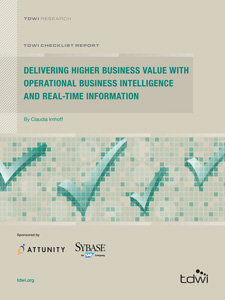
TDWI Checklist Report // Delivering Higher Business Value with Operational Business Intelligence and Real-Time Information
November 29, 2011
Operational BI (OBI) is a popular topic in most business intelligence (BI) shops these days, and rightfully so. OBI enables more informed business decisions by directly supporting specific business processes and activities. It supports faster business decisions by seamlessly integrating BI with business processes to create a closed-loop environment for decision making. Finally, it provides a more dynamic business environment where the business can learn, adapt, and evolve based on the analysis of its operational business performance.
Operational BI is defined as a set of applications, services, and technologies for monitoring, analyzing, reporting on, and managing the business performance of an organization’s daily business operations.
Implementing OBI can be challenging, but new technologies and more sophisticated users and capabilities are driving organizations toward real-time analytics and information flows. These drivers include:
- The business need for low-latency data to support same-day decision cycles
- The need to minimize OBI’s impact on source systems to maximize performance
- The limitations of traditional extract, transform, and load (ETL) solutions in managing big data (increasing data volume, velocity, and variety)
OBI has had a dramatic impact on traditional BI environments and on a new audience of BI users. These users now have immediate access to the insights they need when making decisions about customers, products, and even campaigns while these business activities are happening.
This Checklist Report examines these issues and helps you determine how to align the implementation of operational and real-time BI and analytics technology with true business requirements and capabilities to ensure greater success in reaching business and IT goals.